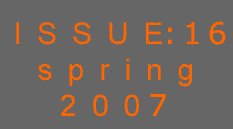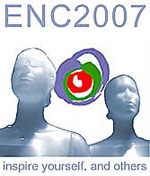ENS NEWS, N° 16:
Intro: The art of communicating science
We live in the age of the bit and the bite, of
ROM and RAM, of software and hard drive. When we are not busy
downloading information, photos or music onto a CD, a DVD, a GSM,
or an MP3, we are blogging or texting or surfing. Of course, every
age has its own language, with its own vocabulary. Language is,
after all, a living thing that is fashioned by evolving social
trends and technological developments. When it stops moving you
know that it’s doomed. The mass of acronyms and linguistic
shortcuts that we use today exemplifies how modern communications
have evolved. In particular it reflects our insatiable appetite
for receiving and processing ever-increasing amounts of information
quickly. This need dictates that brevity, clarity and simplicity
are paramount - not style, elegance or impeccable grammar. If
our communications are unclear or take too long to get to the
point, they are quickly disregarded - in much the same way that
a time-constrained editor bins a press release that hasn’t
grabbed him by the throat after the first couple of sentences.
To those of us brought up on such quaint notions
as grammar and punctuation, it’s quite a shock to discover
that to communicate successfully we need to speak a language that
is rather like fast food - universally available, providing instant
gratification and easily digested. Unfortunately, like some fast
food, this kind of language is often more about packaging than
content and nothing of real substance is communicated. Or is it?
Well, whether you are more comfortable with the
Guide Michelin or the McDonalds schools of language, we all know
that if we can’t master the language we can’t convey
the message. For nuclear communicators it’s rather difficult
to reduce concepts like transmutation, deep geological repositories
or isotope enrichment to a simple concept that anyone can understand.
Of course, there’s nothing new here. Science can often appear
complex to non-scientists. But surely this is one area where we
can and must improve if more people are to be made aware of and
appreciate the many advantages of nuclear energy. At a time when
the nuclear revival is in full flow, the premium on good communications
is all the greater; but so too are the rewards. The anti-nuclear
brigade is often very successful at using communications to influence
public opinion. Of course, we shouldn’t resort to exploiting
common fears and misconceptions like some of our opponents do,
but we can learn from them. We need to constantly upgrade our
communications skills and use them to emphasise the social, economic
and environmental benefits that nuclear energy brings; that’s
a language that everyone can understand. Frank Darwin, son of
Charles, once famously said: “In science the credit goes
to the man who convinces the world, not the man to whom the idea
first occurs.”
Ultimately it’s all about results-oriented
communications. There is little point in having something vitally
important to say if you can’t communicate it effectively.
Nuclear communicators from across the world gathered in Milan
from 11-15 February to focus on this and other central questions
at ENS’ flagship conference for nuclear communicators, PIME
2007. Scientists need to perfect the art of communications to
sell science to a wider and more eclectic, information-hungry
public. That’s the challenge. That’s the PIME message.
Never before has that message been so relevant.
ENS NEWS N° 16 kicks off with a
piece from our President on the Jules Horowitz Research Reactor,
for which the foundation stone was recently laid in Cadarache,
France. Next up is an interesting and insightful contribution
from Andrew Teller on James Lovelock’s seminal work The
Revenge of Gaia.
Edition N°16 includes a bumper ENS Events
section that features recent and upcoming ENS events like PIME
2007 (there’s no escaping that key theme of communications),
RRFM/IGORR 2007, ENC 2007 and EYGF 2007. The continuing success
of these conferences reflect ENS’ significant role as international
conference organizer and catalyst for analysis and reflection
on the key scientific issues of the day.
The Member Societies and Corporate Members section
includes a number of reports and articles from France, Switzerland,
Romania, Sweden and Belgium. The subjects under the scientific
microscope include EDF’s “NICODEME” initiative
that offers research institutes – with financial help from
the European Commission – contracts to carry out advanced
work on nuclear safety; an award-winning doctoral thesis from
a Vrije Universiteit Brussel (VUB) student on how artificial intelligence
can be applied to materials testing – an area of research
in which SCK-CEN in Mol (Belgium) excels; how a series of thematic
seminars (“Scientific and Technical Receptions”) organized
by our colleagues from the Swiss Nuclear Society have helped to
focus on key issues facing the nuclear science community; a drawing
competition for children and young people up to the age of 18
years old organized by the Romanian Nuclear Society and a detailed
analysis of the latest research into nuclear reactor control systems,
which the Royal Institute of Technology (KTH) in Stockholm (Sweden)
has carried out.
There is also a distinctly youthful flavour
to this edition of ENS NEWS, with several reports from
Young Generation Nuclear chapters in Spain, the UK, the Netherlands
and Russia.
The recent 50th anniversary of the Euratom Treaty
provides plenty of food for thought for the EU Institutions section.
Our friends at FORATOM provide an in-depth analysis of the past,
present and future of the Treaty and a general statement on the
applicability and enduring relevance of the Treaty as it reaches
the venerable age of 50.
The ENS World News section goes Down Under to
feature a report on the second state-of-the-art neutron beam measuring
instrument developed by ANSTO in Australia - called, appropriately
enough, “Wombat.” It is used on a sample of opal to
assess how neutron beams penetrate and determine the material’s
atomic structure.
The ENS Members section completes the spring
edition of ENS NEWS.
Enjoy the read and the unusually good spring weather!
| 
Mark O’Donovan
Editor-in-Chief
|
|
|



